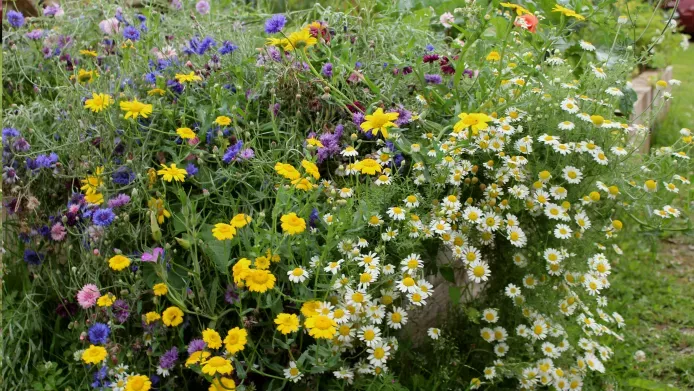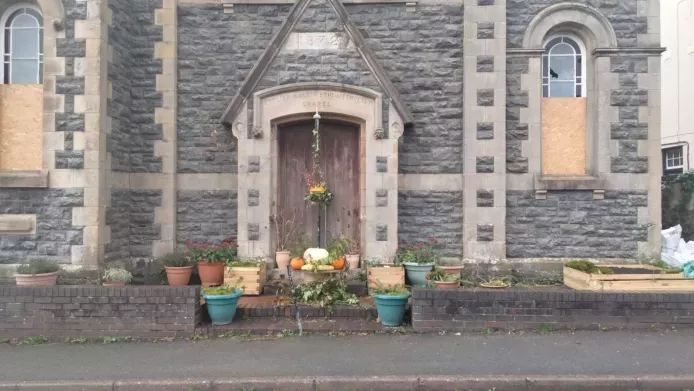We spoke with project leaders from Wen, Tower Hamlets about how they transformed the Limborough Hub community garden as part of the Grow Wild Community Programme 2023. Here they explore their experience creating a diverse growing space for people and plants.
Wen supports cooking and gardening projects in Tower Hamlets, London, with local women and their communities, including many people who are marginalised from mainstream environmental groups and organisations. Our mission at Wen is creating a blueprint for an alternative food system in Tower Hamlets. We work at the Limborough Hub, a community space set up around 10 years ago by Poplar HARCA housing association. They started out by installing raised beds for food growing, followed by a community kitchen, greenhouse, small fruit orchard and an ornamental Chelsea Flower Show Garden designed by Chris Beardsley (donated by Morgan Stanley).
 Limborough hub, Wen, 2023.
Limborough hub, Wen, 2023.
Although relatively well used for growing food, the garden was not being managed for wildlife. A large area of the garden became extremely neglected during the covid-19 lockdowns, becoming dominated by one or two plant species. By joining Grow Wild’s Community Programme, we wanted to turn the space into a wildlife haven and improve biodiversity, by increasing the number of UK native species on site. We also wanted to include some native edibles, such as blackberry (Rubus fruticosus), raspberry (Rubus idaeus) and black elderberry (Sambucus nigra), to suit an urban garden of food lovers.
We wanted to turn the space into a wildlife haven and improve biodiversity, by increasing the number of UK native species on site.

The garden is mostly used by residents of the buildings overlooking the site as well as the wider community, such as people from the surrounding estates. Quaker Social Action support refugees and asylum seekers to cook food in the training kitchen each week and another local organisation, Burdett Football Club operates a food pantry in the space at the weekend. The local women's group has about 30 members who join weekly coffee mornings at the Hub and took part in our Grow Wild growing sessions. We are always coming up with different ideas for workshops and growing projects, in conversation with community.
The area being developed with Grow Wild funding was initially a wildflower meadow, planted eight years ago alongside a beautiful tile covered seat, handmade by children from a local primary school. Lacking attention, the space became an unenjoyable area that residents were afraid of, overgrown and flocked by pigeons. The Grow Wild Community Programme gave us the ability to focus time on this area and create a plan to spruce it up.
The Grow Wild Community Programme gave us the ability to focus time on this area and create a plan to spruce it up.
We employed a freelance gardener, Katalin, from a local growing project called MAD LEAP CIC to design the area and decide on the native plants to plant. We dug up an area of ground that was previously landscaped with plastic netting, along with any intertwined plants. We saved any bulbs we found to be replanted and then re-sowed the space with UK native wildflowers. The bench was also weeded, cleaned and restored to its former glory. We’re sure it will be a lovely calm oasis to relax in next year when all the plants are established, surrounded by all the pollinators enjoying the flowers.
We’re sure it will be a lovely calm oasis to relax in next year when all the plants are established, surrounded by all the pollinators enjoying the flowers.
 Photo copyright Wen. 2023
Photo copyright Wen. 2023
Wildflower seeds sown in the area include: foxglove (Digitalis purpurea), field forget-me-not (Myosotis arvensis), Viper's-bugloss (Echium vulgare), Birds foot trefoil (Lotus corniculatus) , Wild marjoram (Origanum vulgare), Red clover (Trifolium pratense), Red campion (Silene dioica), Yarrow (Achillea millefolium), Purple loosestrife (Lythrum salicaria), Musk mallow (Malva moschata), Oxeye daisy (Leucanthemum vulgare), Meadowsweet (Filipendula ulmaria), Ragged robin (Silene flos-cuculi) and Meadow buttercup (Ranunculus acris).

More UK native flowering plants were put into our ornamental beds, in addition to ordering berry bushes to diversify the food crops growing in the garden. The ground on our site is contaminated; there's still a small amount of lead in the in the soil. By restoring colour and variety in the planting in the garden, we will encourage more wildlife and biodiversity. It will revive that area of the garden and hopefully bring more joy and beauty to the local community who can use it.
By restoring colour and variety in the planting in the garden, we will encourage more wildlife and biodiversity.
Wen planted native flowering plants including wild English bluebell bulbs (Hyacinthoides non-scripta), primrose (Primula vulgaris), sweet violet (Viola odorata), columbine (Aquilega vulgaris), stinking hellebore (Helleborus foetidus), heather (Calluna vulgaris), sweet woodruff (Galium odoratum) and Lady Fern (Athyrium filix femina).
We relied on a lot of people power from corporate groups, who collectively donated over 48 hours of their time who are interested in coming back to volunteer again. This will be important for maintaining the space and it’s good to know we have groups to rely on for bigger jobs.
 Limborough hub wildflower area. Photo copyright Wen. 2023.
Limborough hub wildflower area. Photo copyright Wen. 2023.
In the future we will be running workshops around cooking with berries and preserving things. Making sessions as visual, practical and interactive as possible will be key to the success of this project. At Wen we have experience of working in this way due to years engaging diverse communities, many for whom English is a second language. We also want to produce a child-friendly handbook about plants in the area, to engage local children in the garden, encouraging them to see it as a natural haven in their local area. Katalin from MAD LEAP CIC has also made lists of what is currently planted, which we would like to use to make a map of the garden.
It’s a work in progress, so still more to do!

More Grow Wild Community Project



